|
|
|
Sort Order |
|
|
|
Items / Page
|
|
|
|
|
|
|
| Srl | Item |
| 1 |
ID:
121249
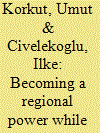

|
|
|
|
|
| Publication |
2013.
|
| Summary/Abstract |
In August 2011 the Turkish prime minister Tayyib Erdogan arrived in
Somalia with a substantial delegation consisting of his family, ministers, and
civil society activists, along with Turkish celebrities, to highlight the need for
greater famine relief. In Mogadishu, Erdogan declared that the tragedy of
Somalia is a test of civilization and contemporary values.1
For any long-term
observer of Turkish interest in Africa, this visit seemed natural-an upshot
of Turkey's aspiration to become a regional power that "displays a superiority
in terms of power capabilities and exerts influence on shaping the regional
order."
2
|
|
|
|
|
|
|
|
|
|
|
|
|
|
|
|
| 2 |
ID:
121250
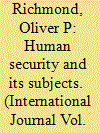

|
|
|
|
|
| Publication |
2013.
|
| Summary/Abstract |
The UN has changed the world by combining liberal internationalism,
the state, and liberal institutionalism, as well as by endeavouring to place
the subjects of security first. The notion of human security (HS) emerged
through these processes and through the convergence of various concepts,
including peacekeeping, human rights, development, and peace-building.
HS has been central to the UN's recent normative and legal impact and to
the UN's many peacekeeping and peace-building environments around the
world.
|
|
|
|
|
|
|
|
|
|
|
|
|
|
|
|
| 3 |
ID:
121247
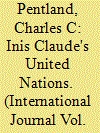

|
|
|
|
|
| Publication |
2013.
|
| Summary/Abstract |
On 1 October 2012 Canada's foreign minister addressed the United Nations
general assembly. Embedded in an otherwise bland text were several sharp
jabs at the UN, notably concerning the self-absorption of the organization's
internal reform processes and the inadequacy of its response to humanitarian
crises such as that engulfing Syria.1
These criticisms, predictably echoed in
the right wing of the Canadian media, soon evoked ripostes whose burden
was that the minister seemed woefully, perhaps willfully, ignorant of the
organization he was criticizing: UN reform is a process for which western
governments, including Canada's, had pressed for years; and it was some
member-states, not the UN as such, that were hesitant over Syria.2
|
|
|
|
|
|
|
|
|
|
|
|
|
|
|
|
| 4 |
ID:
121239
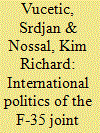

|
|
|
|
|
| Publication |
2013.
|
| Summary/Abstract |
There is a good reason why the F-35 Joint Strike Fighter program is so often
described as the "arms deal of the century." In a report published on the last
day of 2010, the Pentagon estimated lifetime operating and sustainment
costs for the US F-35 fleet-then projected at 2,443 units, not counting
the prototypes-at US$1.45 trillion.1
Cost analyses of this type are always
much-debated: How many units will be sold in total? How does one define "lifetime"? How reliable will the system be once it enters service? What
will be the nature of its deployment? And so on. Beyond dispute is that the
F-35 constitutes one of the largest, if not the largest, weapons programs in
modern history.
|
|
|
|
|
|
|
|
|
|
|
|
|
|
|
|
| 5 |
ID:
121244
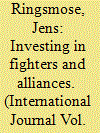

|
|
|
|
|
| Publication |
2013.
|
| Summary/Abstract |
In the spring of 1975 Norway and Denmark were faced with the choice
of how to replace their aging fleets of fighter jets. Together with Belgium
and the Netherlands, the two Nordic countries had established a "buyers'
consortium" to ensure NATO standardization and a strong bargaining
position vis-à-vis the potential suppliers; hence Copenhagen and Oslo
were in very similar situations. As the final decision was about to be made,
three candidate planes were still in the competition: the American F-16, the
Swedish Saab Viggen, and the French Dassault Mirage. After a drawn-out
and exceedingly complex decision-making process, the four European NATO
members together opted for the American contender. Surely, the Danish
and Norwegian decision to procure the F-16 had several reasons behind it-
importantly, most policymakers in both Copenhagen and Oslo considered
the American aircraft to be technically superior to its competitors-but
the choice of the F-16 was in no small part motivated by old-fashioned realpolitik. The purchase of new fighter jets was thus not only perceived as a
procurement of new military equipment but also an investment in alliances
and the transatlantic link. Accordingly, Norway and Denmark chose the
American F-16 partly because this aircraft was thought to bring the greatest
strategic benefits.1
|
|
|
|
|
|
|
|
|
|
|
|
|
|
|
|
| 6 |
ID:
121241
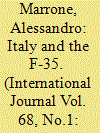

|
|
|
|
|
| Publication |
2013.
|
| Summary/Abstract |
Italy's participation in the F-35 procurement program was initially decided
in 1998 by the left-wing government under Massimo D'Alema, the leader of
the former Italian Communist Party, which invested US$10 million in the
Concept Demonstration Phase (CDP) of the program. In 2002 the rightwing government led by Silvio Berlusconi confirmed this strategic choice by
committing $1.028 billion to the System Design and Development (SDD)
phase and by signing the US-Italy memorandum of understanding (MOU).
In 2007 the left-wing government guided by Romano Prodi signed the
bilateral MOU for the Production, Sustainment, and Follow-on Development
(PSFD) phase with an investment of $904 million.
|
|
|
|
|
|
|
|
|
|
|
|
|
|
|
|
| 7 |
ID:
121248
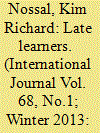

|
|
|
|
|
| Publication |
2013.
|
| Summary/Abstract |
Looking at the process that the Conservative government of Stephen Harper
tried to use to replace the Royal Canadian Air Force's aging CF-18 Hornet fleet
with 65 Lockheed Martin F-35 Lightning II Joint Strike Fighters, it is hard
to disagree with Andrew Coyne's assessment that the acquisition program
was "a fiasco from top to bottom, combining lapses of professional ethics,
ministerial responsibility and democratic accountability into one spectacular
illustration of how completely our system of government has gone to hell."1
For the evolution of Canada's participation in the F-35 program-from
the first memorandum of understanding (MOU) signed by the Liberal
government of Jean Chrétien on 2 January 1998 to the so-called "reset" of
the program in December 2012-readily fits the nouns the Canadian media
so commonly used to characterize the F-35 acquisition: fiasco, debacle, mess,
scandal, and shambles in English, or fiasco, scandale, incompétence, gâchis
(mess), gouffre financier ("money pit") in French.
|
|
|
|
|
|
|
|
|
|
|
|
|
|
|
|
| 8 |
ID:
121243
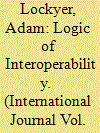

|
|
|
|
|
| Publication |
2013.
|
| Summary/Abstract |
Since 1918, Australia has joined the United States in every one of its major
conflicts: World War Two, Korea, Vietnam, the Persian Gulf, Somalia,
Afghanistan, and Iraq. Australia's enduring commitment to the alliance has
led to a renewed focus on joint operations. The new maxim within Australian
defence circles is "interoperability." Interoperability with the US military
has become the keystone phrase for many issues relating to Australia's
procurement, strategy, and doctrine. Yet the other phrase used equally as
often is "self-reliance." Australian strategic planners simultaneously view the
US as an indispensable and unreliable ally. Although Australia has always
been at America's side, Australia was disappointed by the unenthusiastic
response of the US to the 1999 East Timor crisis. As such, the underlining
logic of interoperability is to hedge between dependence and self-reliance.
|
|
|
|
|
|
|
|
|
|
|
|
|
|
|
|
| 9 |
ID:
121242
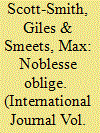

|
|
|
|
|
| Publication |
2013.
|
| Summary/Abstract |
In the late 1990s the Dutch government under Labour minister-president
Wim Kok decided to pursue a replacement for the main strike fighter of the
Royal Netherlands Air Force (RNAF), the F-16. From very early on, there
was a strong preference for the F-35 Joint Strike Fighter (JSF). This position
has held through the subsequent seven governing coalitions, even though
the political balance on the issue has fluctuated over time. Politicians have
presented the decision to participate in the JSF development program as an
entirely separate issue from that of replacing the F-16. Every government
since 1996 has insisted in public that the one issue does not necessarily lead
to the other, even though this has become an increasingly untenable division
to maintain.
|
|
|
|
|
|
|
|
|
|
|
|
|
|
|
|
| 10 |
ID:
121246
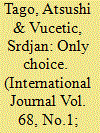

|
|
|
|
|
| Publication |
2013.
|
| Summary/Abstract |
The United States has two faithful allies in Canada and Japan. Established at
different points in the twentieth century, the two alliances have grown and
flourished, helping to maintain an American-led order in the Asia-Pacific
and beyond. By any reasonable measure, few states are as integrated in
the American security sphere as these two. In David A. Lake's index of US
"security hierarchy," which measures a variety of bargaining mechanisms
through which states voluntarily trade autonomy and sovereignty for order,
prosperity, and cheaper security provided by the US, Japan ranks fifth and Canada eighth.1
From this perspective, it is not surprising that Japan and
Canada are participating in the F-35 Joint Strike Fighter (JSF) program.
|
|
|
|
|
|
|
|
|
|
|
|
|
|
|
|
| 11 |
ID:
121245
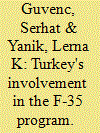

|
|
|
|
|
| Publication |
2013.
|
| Summary/Abstract |
Turkey has been involved in the international consortium that builds the
F-35 Joint Strike Fighter (JSF) since 1999. The relationship between Turkey
and the consortium may appear to be rocky, however, because of Turkey's
many hesitations to commit to the JSF program. In this article we argue that
these hesitations are strategic, designed to extract maximum benefits for
Turkey's defence industry from the consortium manufacturing the fighter
jets. For in addition to wanting to buy these fighter jets, Turkey seeks to
maximize the amount of local work-share to secure access to the software
of the aircraft, and to accumulate enough experience that will eventually
lead to designing and manufacturing a "fully indigenous" combat aircraft.
|
|
|
|
|
|
|
|
|
|
|
|
|
|
|
|
| 12 |
ID:
121240
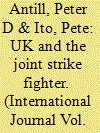

|
|
|
|
|
| Publication |
2013.
|
| Summary/Abstract |
The 20 years since the end of the Cold War have seen a radical shift in the
nature of the defence industrial sector, with a rationalization of the number
of companies involved. While something similar happened in the civilian
aerospace market, which has become dominated by two giant rivals-the
United States-based Boeing Corporation and the European consortium of
Airbus-it occurred over a much shorter timescale. For example, in the US
defence market Boeing merged with McDonnell Douglas in August 1997;
Lockheed and Martin Marietta merged in March 1995; while Northrop
Aircraft acquired Grumman Aerospace in April 1994.1
Today the defence
market is increasingly dominated by a smaller number of large multinational
companies that have global interests, such as Boeing, Lockheed Martin, General Dynamics, Northrop Grumman, Raytheon, EADS, Thales, and
BAE Systems. In conjunction with this slow but steady rationalization, most
western countries since the end of the Cold War have sought some form
of "peace dividend" and diverted resources from defence to other areas of
public expenditure.2
For example, the United Kingdom's defence expenditure
dropped as a percentage of Gross Domestic Product (GDP) from 4.6 percent
in 1987 to 2.56 percent in 2010. This drop mirrored much of what was
happening in the rest of NATO, with the average defence expenditure falling
from 1.93 percent in 2001 to 1.58 percent in 2010.3
|
|
|
|
|
|
|
|
|
|
|
|
|
|
|
|
|
|
|
|
|